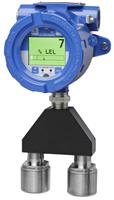Yodify Product Library
Add the SenSmart 6900 DUAL Gas Detector to your store or catalog
Book Your Demo and See How
or create your store
SenSmart 6900 DUAL Gas Detector
Brand: R.C. Systems Co.Dual gas detectors support the use of two smart sensors including electrochemical, catalytic bead, infrared and photoionization sensors.
The state-of-the-art SenSmart 6900 gas detector is built with our proven ‘ST-44’ transmitter and has an RS-485 remote sensor option with a range of up to 4000 feet.
This versatile unit also has a bright, vivid color LCD display and embedded Ethernet with Webserver and Modbus TCP.
Sensor Options for Dual Gas Detectors
Dual gas detectors from RC Systems can be equipped with one or more different sensors based on your application requirements.
We offer electromechanical sensors, catalytic bead sensors, infrared sensors and photoionization sensors for monitoring a range of toxic and combustible gases and vapors.
Electrochemical Sensors
Electrochemical sensors are typically used for monitoring oxygen and toxic gas levels and feature two or more electrodes and an electrolyte.
As gas diffuses into the sensor, it is oxidized or reduced. This action results in a current that is measured by the electrode to produce a reading.
Electrochemical sensors have excellent accuracy and repeatability but can also be sensitive to humidity and temperature variations.
Because of this, RC Systems takes pride in helping you with your specific application to better understand how to best utilize our electrochemical gas detectors.
Catalytic Bead Sensors
Catalytic bead sensors are used for the monitoring of combustible gases and feature two platinum wire coils that are embedded in beads of alumina and connected to a Wheatstone bridge electrical circuit.
To detect the presence of combustible gas, one of the pellistors in the sensor contains a catalyst that oxidizes the gas upon contact. Catalytic bead sensors are highly reliable and can be used with any type of combustible gas.
They are also suitable for use in high humidity and extreme temperature environments, and around vibrating machinery.
Infrared Sensors
Infrared (IR) sensors feature an infrared light source, optical filter and optical receiver measure gas levels by transmitting infrared light.
The most common application is to detect the presence of hydrocarbon vapors and other combustible gases, though they may also be used for oxygen monitoring.
If gas is present, it interferes with the transmission of the infrared light. This change is then detected by the receiver, which determines the gas level by measuring the energy difference.
Infrared sensors remain operational in various temperatures and humidity levels and can withstand pressure. They also remain functional in oxygen-deficient environments and the sensors do not wear with repeated exposure to gas.
These characteristics make infrared dual gas detectors suitable for use in mining applications and other hazardous environments.
Photoionization Sensors
Photoionization sensors are used in dual gas detectors to measure volatile organic compounds typically found in fuels, solvents, degreasers and other items frequently used in manufacturing and waste handling.
The photoionization sensors contain high-energy UV photons that break molecules into positively charged ions that produce a current as they enter the sensor.
Higher concentrations of gas produce a larger number of ions, which creates a larger current that triggers a reading to display on the dual gas detector screen.
Features- CSA Certified for Class 1, Div 1 locations
- Vivid QVGA Backlit Color TFT Display
- Display Color Changes with Alarm Status
- Standard Ethernet Port with Web Server and Modbus TCP
- Dual Smart Sensor Capable
- Sensor Life Indication
- Remote Sensor Mount up to 4000’
- Non-intrusive One-Man Calibration
- Temperature Compensation
- Two RS-485 Ports for Modbus
- 3 Programmable Relays and Fault Relay Available
- Heated elements available for low temperature
Specifications
Brand
Power Supply
- 10-30 Vdc at < 10 watts with Relay board (All Relays energized)
Display
- QVGA backlit color TFT 320 x 240
Channel Two Input
- Electrochemical, Infrared, Sensor
Standard Output
- Ethernet RJ45 with built-in web Server, Modbus/TCP
- Maximum loop Resistance 600 ohms @ 24 Vdc
- Dual 3-Wire 4-20 mA Current source
Optional Outputs
- Dual Programmable Master / Slave Modbus RS-485 Serial interfaces
- Three Programmable Relays plus Dedicated FAULT Relay (Form C, rated 5 amp at 30 Vdc or 240 ~Vac RESISTIVE)
Environmental
- Operating Range -40° to +60° C Sensors include Sensor Heater for Low Temperature Operation Relative Humidity to 95 % for IR, to 85 % noncondensing when using Electrochemical Sensors
Housing
- Optional Ul94 Poly Black Plastic Enclosure
- Optional #316 Stainless Steel
- Aluminum with Epoxy Paint Standard
Dimensions
- (Poly) Width 5" (127 mm), Height 7" (178 mm), Depth 4" (101 mm) Shipping weight 3 pounds (2 kg)
- (Aluminum) Width 5.4" (137 mm), Height 8" (203 mm), Depth 5" (127 mm) Shipping weight 6.5 pounds (3 kg)
Approvals
- UL 94 Poly Black Plastic Enclosure: Non-Incendive Class I, Div. 2 Grade A, B, C, D IP66
- Cast Aluminum Enclosure: Explosion-Proof Class I, Div. 1 Grade A, B, C, D with 10-0247 (Includes sinter) Non-Incendive Class I, Div. 2 Grade A, B, C, D with 10-0247 or 10-0247IS
Warranty
- 5 Year limited warranty
- For Sensor warranty see Sensor Specifications sheet. .





